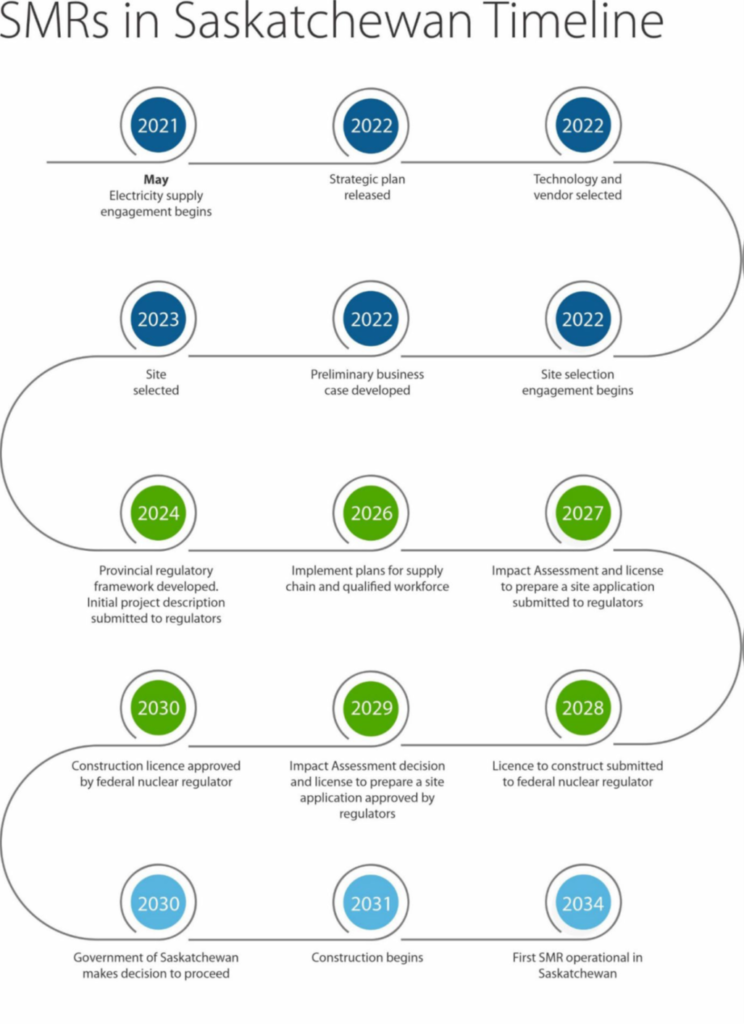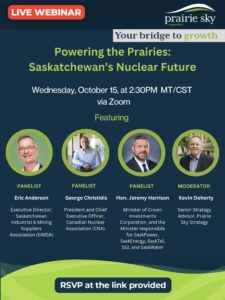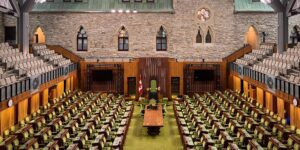The governments of New Brunswick, Ontario, Saskatchewan and Alberta released “A Strategic Plan for the Deployment of Small Modular Reactors,” a 60-page document to advance next steps in Small Modular Reactor (SMR) development and deployment in Canada.
History & Background
Beginning in December 2019, governments in Ontario, New Brunswick and Saskatchewan joined forces through an interprovincial Memorandum of Understanding (MOU) to advance SMRs. Initially, utilities in each of the three founding provinces generated a SMR feasibility study in April 2021, after which Alberta signed onto the MOU. The feasibility study foresaw a first grid-scale SMR of around 300 MW at Darlington in Ontario by 2028, followed by subsequent project development in Saskatchewan with the first project operational by 2032.
The Strategic Plan completes the original MOU’s deliverables, but also outlines further actions to advance SMR deployment.
Five Priority Areas
The Strategic Plan identified five priority areas to advance SMRs in Canada, some of which were already summarized in the group’s 2021 feasibility study.
Technology readiness
The strategy recycles three streams for early deployment that were already identified nearly a year ago in the provinces’ SMR feasibility study, but with some revised timelines:
- Stream 1: the strategy retains the plan for a first grid-scale 300 MW SMR at Darlington in Ontario by 2028 (using GE-Hitachi’s technology, after a multi-year due diligence process), followed by four units in Saskatchewan with the first operational by 2034, two years later than foreseen in the feasibility study. SaskPower is expected to announce its preferred vendor selection in coming months.
- Stream 2: two fourth-generation advanced SMRs to be developed in New Brunswick by 2029 and in the early 2030s.
- Stream 3: micro-SMRs for remote micro-grid use, including an initial 5 MW demonstration project at Chalk River, Ontario, by 2026.
None of the plans in these streams cite a specific project for Alberta.
Regulatory framework
As with the feasibility study, the strategy identifies the federal government’s and Canadian Nuclear Safety Commission’s role in full life-cycle licensing and regulation, including nuclear waste management and disposal. In particular, the strategy calls for “regulatory changes and clarity … to streamline the federal regulatory and licensing process for SMR projects recognizing SMR technologies are of lower risk and feature enhanced safety characteristics compared to traditional large-scale nuclear projects.” These are necessary to “ensure reasonable costs and timelines for approvals for investors and operators.”
Economics and financing
The strategy notes the high upfront financial investment for developing and deploying “first-of-a-kind” designs, calling on the federal and provincial governments to “share the financial risk”. In particular, the provinces are asking the federal government for “assurance that it will allocate financial support” for the projects outlined in the three streams above.
Nuclear waste management
The strategy states the industry-led Nuclear Waste Management Organization (NWMO) is working to identify a “willing host community” for a deep geologic repository. The NWMO has short-listed two sites in Ontario from 22 applicant communities, with plans to select a single preferred site in 2023 to begin operating in the early 2040s. The strategy makes clear that the four MOU provinces are monitoring the federal government’s radioactive waste policy development to ensure it is appropriate for small SMR operations, including in western Canada.
Indigenous and public engagement
Noting that the MOU commits the provinces to inform the public specifically about the economic and environmental benefits of SMRs, the strategy notes the provinces have also highlighted the important role of Indigenous and public engagement in SMR development as part of Canada’s SMR Roadmap, led by NRCan. The four MOU provinces commit in the Strategic Plan to collaborating to extol the economic and societal benefits of nuclear energy.
Next Steps
For next steps, the Strategic Plan points to detailed planning work by provincial power utilities with SMR technology developers to enable provincial decision-making, such as completing detailed design, planning, preparation and licensing to meet the “technology readiness” timelines, and refining project costs and schedule estimates.
Meanwhile, provincial governments will undertake risk-benefit analysis around projects, assessing impacts on electricity systems and ratepayers, emissions outcomes, and potential for Indigenous partnerships. Moreover, the provinces will continue to pursue financial and policy supports from the federal government for SMR development.
The View from the Prairies
Both Saskatchewan and Alberta jointly released the Strategic Plan along with their two other MOU partners. However, the focus and anticipated roles vary considerably between the provinces.
Saskatchewan
Saskatchewan took a lead role in communicating the Strategic Plan, which matches its strong ambitions for 1,200 MW of SMR generation between 2034 and 2042 and for growing uranium extraction. It notes that construction of the first 300 MW SMR could start as “early as 2030 and be operational by 2034”.
This will begin with technology and vendor selection by SaskPower this year, followed by site selection by 2023. With planning and licensing work to proceed over the balance of the decade, the government of Saskatchewan would be ready to decide whether to proceed in 2030, which would see construction begin in 2031 and operation in 2034.

[Source: A Strategic Plan for the Deployment of Small Modular Reactors, p.51]
Unfortunately, some reporting of government comments last week painted a more aggressive and urgent picture of this development, noting that Premier Moe was looking “very shortly” to change the fact that Saskatchewan doesn’t generate nuclear energy. The piece made clear that although SaskPower is beginning to assess technology and locations, it has not yet made a decision around generating nuclear energy. However, it also indicated a SMR could be operating in Saskatchewan as early as 2030. The Strategic Plan makes clear – and SaskPower confirmed – that only a provincial government decision would be possible by 2030, with operations not starting until 2034. Because of the long development cycle on nuclear energy, for SMRs to be on the table, SaskPower needs to begin planning immediately, with the initial focus on only the first 300 MW unit.
In grappling with the need to decarbonize electricity generation, Premier Moe indicated a strong interest in SMRs, noting that they are “most certainly one of those options”, but also pointed to “additional carbon capture and storage” for enhanced oil recovery. As technology costs remain uncertain, SaskPower Minister Don Morgan noted “We’d also be open to looking at a variety of options to providing base load power for the province”, but focused on the need for “base load power”, which he says solar and wind energy cannot provide.
Alberta
Alberta, meanwhile, expresses a more tentative position in pursuing SMRs. Energy Minister Sonya Savage focused her comments around the opportunity of SMRs in Alberta on supplying energy for remote industrial operations and helping to reduce emissions for oil sands extraction and processing. With respect to power generation, however, the Strategic Plan explicitly notes that these are “private investments within a competitive market” in Alberta and the province does not “endorse one project over another as a matter of policy.” Indeed, the Alberta Electric System Operator’s (AESO’s) 2022 Net-Zero Pathways Preliminiary Results, also released yesterday, foresees no nuclear energy development in Alberta under any of the three net-zero scenarios modelled, though it acknowledges nuclear as an “alternative approach that could achieve decarbonization policy objectives” that would likely require government support and require a 10-year development cycle.
Interestingly though, the Strategic Plan notes that provincial policy tools applicable in “all signatory provinces” include supporting SMR cost recovery through power purchase agreements, electricity rate regulation (rate-regulated asset), and provincial government funding. Each of these is either in tension with or outright contradictory to the province’s “fair, efficient and openly competitive” (FEOC) market. Why these approaches were cited for “all signatory provinces” instead of under the “Ontario, New Brunswick and Saskatchewan” section is fodder for some confusion for Alberta’s generation investors.
Alberta’s specific plans focus predominantly on SMR use in remote industrial operations and for non-emitting energy needed for oil sands extraction. For immediate actions, Alberta notes the positioning of SMRs within its innovation ecosystem, the opportunity for investment supports for SMR technology and knowledge development, and the need to ready regulatory apparatuses to enable private investment in SMRs. The province also invites proponents to submit an application for the development of a new offset protocol for nuclear electricity or heating, even as the government signals the need to manage credit and offset supply and potentially curb the opportunity for renewable energy offset generation under the forthcoming TIER Renewal engagement.
Contact Us
The Strategic Plan and reporting around it creates some risk of confusion for investors in Saskatchewan and Alberta electricity generation and infrastructure. Prairie Sky maintains close relationships with decision-makers in both provinces and can help your organization work through these complexities to find greater clarity and understanding
Ben Thibault – Senior Strategy Advisor
ben@prairieskystrategy.ca
587.897.6261
Kevin Doherty- Senior Strategy Advisor
kevin@prairieskystrategy.ca
306.570.7123
Richard Truscott- Vice-President
richard@prairieskystrategy.ca
403.998.0494
Jeff Sterzuk – President
jeff@prairieskystrategy.ca
587.393.7756
To learn more about Prairie Sky Strategy, please visit our website.





